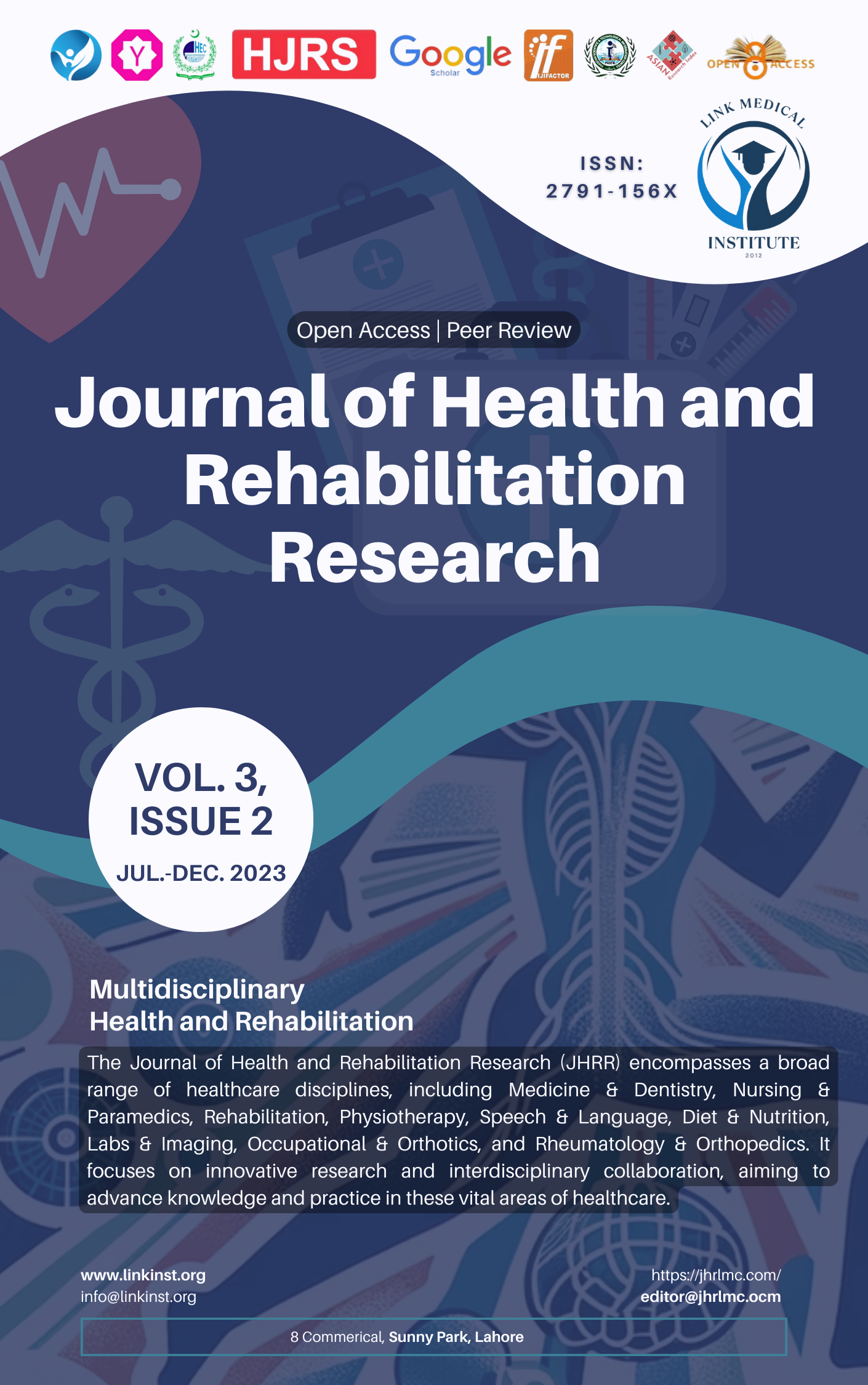Prevalence of Goiter Disease to the Human Population of District Buner, Khyber Pakhtunkhwa, Pakistan
DOI:
https://doi.org/10.61919/jhrr.v3i2.184Keywords:
Goiter, Thyroid Enlargement, Prevalence, Iodine Deficiency, District Buner, Epidemiology, Public HealthAbstract
Background: Goiter, an enlargement of the thyroid gland, continues to be a significant global health issue, affecting approximately ten million people worldwide. The prevalence of goiter is notably influenced by geographical and environmental factors, such as soil iodine content, especially in hilly terrains. Prior research has indicated a gender and age-related predisposition to the condition, with varied prevalence across different regions.
Objective: This study aimed to ascertain the prevalence and demographic distribution of goiter in District Buner, Khyber Pakhtunkhwa, Pakistan, and to compare these findings with data from other regions to better understand the condition's epidemiological characteristics.
Methods: A cross-sectional study was conducted from September 2021 to September 2022. A total of 280 patients from six tehsils within District Buner were investigated through questionnaires and medical examinations by healthcare professionals. Data collection occurred weekly across multiple healthcare facilities, including medical centers, rural health centers, and the District Headquarters Hospital in Buner.
Results: Out of 280 patients, 78% were females, indicating a higher prevalence among women. The highest prevalence among males (33%) was recorded at 70 years of age, while for females, it peaked (86%) at 50 years. The majority of cases belonged to the age group of 30-60 years. Multinodular goiter was the most common type observed. The data also reflected a higher incidence of goiter in hilly regions compared to plain areas, likely due to iodine deficiency.
Conclusion: The study confirmed that goiter is more prevalent among females and tends to increase with age. The high incidence in hilly areas supports the association with low soil iodine content. This research underscores the need for targeted public health strategies, including iodine supplementation and education, particularly in at-risk areas.
Downloads
References
Ambad R, Jain P, Kambale A, Mahakalkar C. Thyroid profile in goiter patients. European Journal of Molecular & Clinical Medicine. 2021;8(01):2021.
Shah N, Ursani TJ, Shah NA, Raza HMZ. Prevalence and etiology of thyroid disease: A review. Pure and Applied Biology (PAB). 2021;10(3):691-702.
Costoff A. Sect. 5, Ch. 6: Anatomy, Structure, and Synthesis of Calcitonin (CT). Endocrinology: hormonal control of calcium and phosphate. 2008.
Sharma P, Magar NT, Mahesh B. Prevalence of thyroid disorder in residents of Western region of Nepal. International Journal of Applied Sciences and Biotechnology. 2021;9(3):169-75.
Alam¹ Z, Shah M, Khan M, Ali W, Shehzad A, Shah JA, et al. Thyroid Dysfunction and Prevalence of both clinical and subclinical form of Hyperthyroidism and Hypothyroidism in District Mardan, KPK, Pakistan. Bull Env Pharmacol Life Sci. 2019;8:98-104.
Colledge NR, Walker BR, Ralston S, Davidson LSP. Davidson's principles and practice of medicine. (No Title). 2014.
Moosa FA, Junaid M, Khan FW, Afzal Y, Sultan N. Prevalence of malignancy in resected specimen of patients operated for benign nodular goitre. Pak J Surg. 2007;23(2):129-32.
Taylor PN, Albrecht D, Scholz A, Gutierrez-Buey G, Lazarus JH, Dayan CM, et al. Global epidemiology of hyperthyroidism and hypothyroidism. Nature Reviews Endocrinology. 2018;14(5):301-16.
SUKKUR D. GOITER.
Frilling A, Liu C, Weber F. Benign multinodular goiter. Scandinavian journal of surgery. 2004;93(4):278-81.
SW H, SA N. A study of goiter among female adolescents referred to centre for nuclear medicine, Lahore. 2005.
Mitchell KJ, Ybarra M, Finkelhor D. The relative importance of online victimization in understanding depression, delinquency, and substance use. Child maltreatment. 2007;12(4):314-24.
Subhan F, Jahangir M, Saira S, Khattak RM, Shahab M, Haq M, et al. Prevalence of goiter and iodine status among 6-12 years school age children in district Kohat, Pakistan. South East Asia Journal of Public Health. 2015;4(2):42-6.
Wajiha RA, Afridi H, Saeed K. Prevalence of culex, aedes, anopheles and armigers mosquitoes at selected localities of district Peshawar Khyber Pakhtunkhwa Pakistan. International Journal of Mosquito Research. 2017;4(2):128-34.
Ullah I, Asif M, Alam N, Ali S, Haq IU, Khan I. Study on the Prevalence of Goiter and Associated Factors Among Hospitalized Patients of District Timergara, Dir Lower Pakistan. Biomedical Journal of Scientific & Technical Research. 2022;41(2):32458-63.
Hennekes M, Rahman S, Schlosser A, Drake A, Nelson T, Hoffberg E, et al. The PEGASUS Games: Physical Exam, Gross Anatomy, phySiology and UltraSound Games for Preclinical Medical Education. Pocus j. 2021;6(1):22-8.
Tovkai A. Iodine deficiency and prevalence of nodular goitre in Ukraine. International Journal of Endocrinology (Ukraine). 2022;18(4):226-30.
Yalagachin G, Lakshmikantha N, Mashal SB. Prevalence of nodular goiter in patients with breast diseases. J Clin Invest Surg. 2020;5(2):91-5.
Gebremichael G, Demena M, Egata G, Gebremichael B. Prevalence of goiter and associated factors among adolescents in Gazgibla District, Northeast Ethiopia. Global advances in health and medicine. 2020;9:2164956120923624.
Akhtar N, Ilyas M, Muhammad K, Shams S, Saeed K, Asadullah A. Prevalence of Hepatitis C virus infections among the general population of Buner, Khyber Pakhtunkhwa, Pakistan. Biomedical Research and Therapy. 2016;3(12):1003-17.
Bawa D, Khan S, Khalifa Y, Sharma S, Alghamdi A. Retrospective Study on the Incidence of Thyroid Disorders in Bisha and Evolving Surgical Management Considerations. Int J Surg Res Pract. 2021;8:130.
Downloads
Published
How to Cite
Issue
Section
License
Copyright (c) 2023 Priyanka Singh, Muhammad Asif, Shaista Khan, Naila Sarki, Ali Raza, Amina Rahat, Hafiz Haris Mahmood, Tahir Azeem, Hameed Ur Rehman, Barika kour, Kausar Saeed

This work is licensed under a Creative Commons Attribution 4.0 International License.
Public Licensing Terms
This work is licensed under the Creative Commons Attribution 4.0 International License (CC BY 4.0). Under this license:
- You are free to share (copy and redistribute the material in any medium or format) and adapt (remix, transform, and build upon the material) for any purpose, including commercial use.
- Attribution must be given to the original author(s) and source in a manner that is reasonable and does not imply endorsement.
- No additional restrictions may be applied that conflict with the terms of this license.
For more details, visit: https://creativecommons.org/licenses/by/4.0/.






